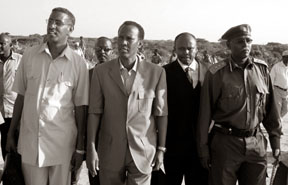|
observer |
|
|
|
|
|
OTHER LINKS |

|

|

|
Intricate mix of clans and grievancesThe collapse last week of the Islamic Courts Union in Mogadishu is reviving old clan rivalries that experts say will play a key role in Somalia's future. The following is a primer on the nation's clans. There are six main clans and minority groups, and dozens of subclans.
Hawiye, the largest by number, are historically based in central Somalia and the capital, Mogadishu, though, like most clans, can be found all over the country. Darod are found in Puntland in the north, as well as being from the Ogaden region of Ethiopia, though many also live in the south. Rahanweyn are found in Lower Shabelle, Baidoa and other areas. Dir, including Isaak, are mainly in Somaliland, a self-declared republic that broke from Somalia in 1991. The Jarer and Banadiri are smaller and often work together to boost their clout. The 1991 collapse of Mohamed Siad Barre's regime sparked clan wars, with large and more powerful groups attacking smaller rivals. At the same time, there were intraclan conflicts involving Hawiye and Darod in Mogadishu and Kismayo. The conflicts led to a massive "reclanization," as Somalis resettled to be closer to their traditional clan base for protection. Barre was a member of the Darod. His subclan dominated Mogadishu and its resources. After 1991, Hawiye tribes, working with Darod subclans who opposed Barre, invaded the capital and drove out some Darod subclans and other clans, seizing land, homes and property. Many of those grievances have yet to be resolved. Transitional President Abdullahi Yusuf is a Darod. Before he became president, he led his clan's fighters in civil war clashes against Hawiye. Many Hawiye fear he will use his position to seek retribution. The Islamic Courts Union temporarily unified various clans under Islam. But even before the alliance collapsed, familiar clan rivalries were beginning to emerge because nearly all of the courts officials were Hawiye. The Hawiye clan is divided into many subclans whose rivalries often surpass the tensions between Darod and Hawiye. Prime Minister Ali Mohammed Gedi, a former professor of veterinary medicine who lived in Ethiopia, won his job in part because he comes from an important Hawiye subclan in Mogadishu, but many in the group do not support him, leading to credibility problems. His subclan is seen as being one of the two most antagonistic toward the transitional government. The second is the Hawiye subclan of Sheik Hassan Dahir Aweys, former chairman of the Islamic courts. Both subclans are thought to be heavily armed and reluctant to heed the government's call to disarm. LA Times |









